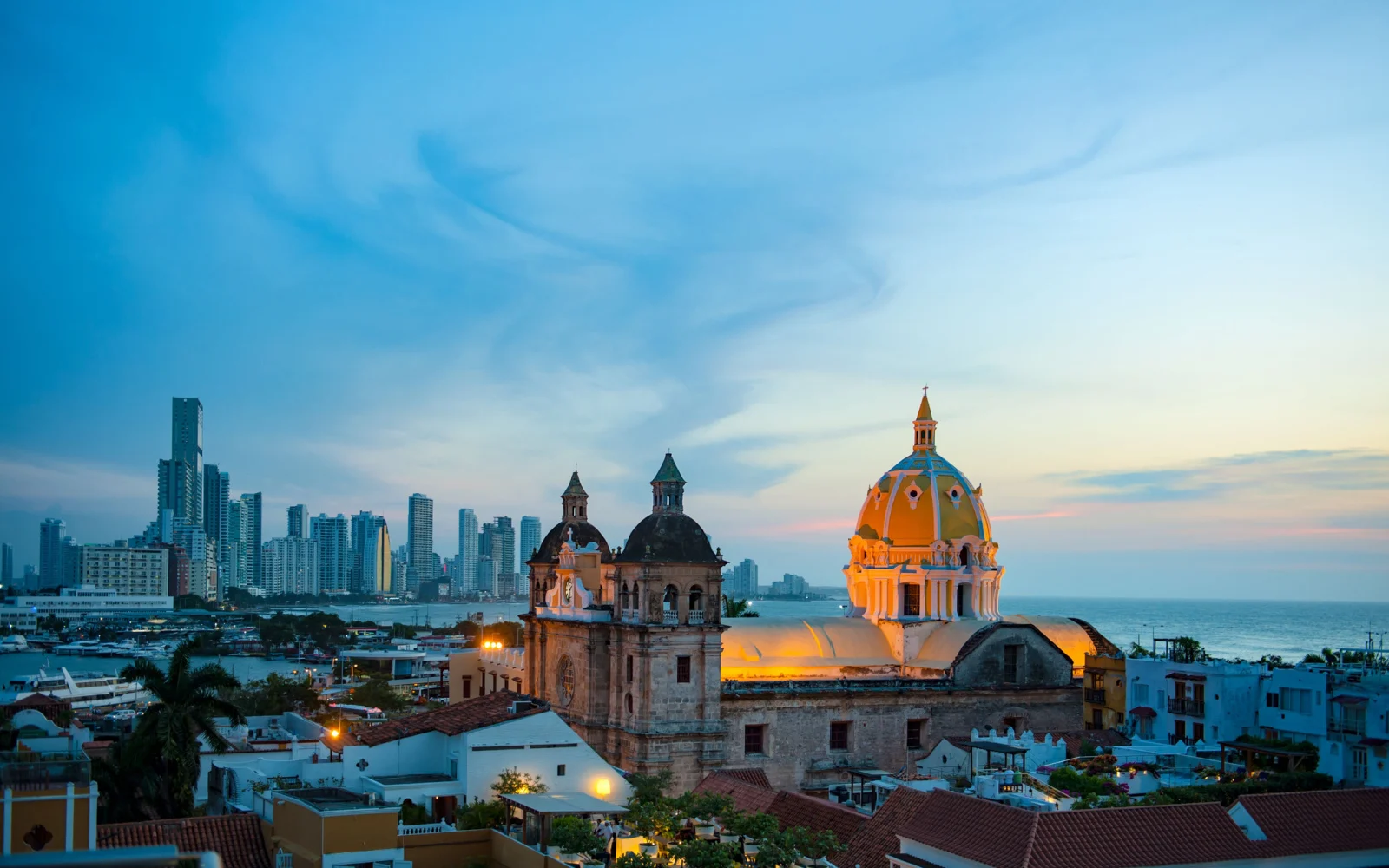What's the best time to visit Cartagena?
The best time to visit Cartagena is from December to April, the dry season offering ideal weather for exploring and participating in events like the Hay Festival and Barranquilla Carnival. This peak period attracts a diverse crowd, enhancing the city’s vibrant atmosphere. Despite the crowds, the pleasant climate makes it perfect for outdoor activities, festivals, and markets.
The beautiful Colombian city of Cartagena is one of the country’s most popular destinations, whether you’re looking for a city break or a beach vacation. The center of Cartagena is the perfectly preserved walled 16th-century colonial city.
It’s located right on the Caribbean Sea — you can lounge on the beach near Bocagrande and soak up the tropical sunshine. Visitors also love the vibrant Caribbean culture with a diverse food scene, lively music, and dancing.
You’ll find it hard to tear yourself away from the parties in the street! There’s a lot to do in Cartagena, but its location on the coast means that it’s strongly affected by seasonal weather patterns. That makes it imperative to pick the right time to visit.
Let’s take a look at the best, cheapest, least crowded, and worst time to visit Cartagena below. We’ll talk about what to expect in terms of weather, costs, crowds, and events in this spirited Colombian city!
Overall Best Time to Visit Cartagena
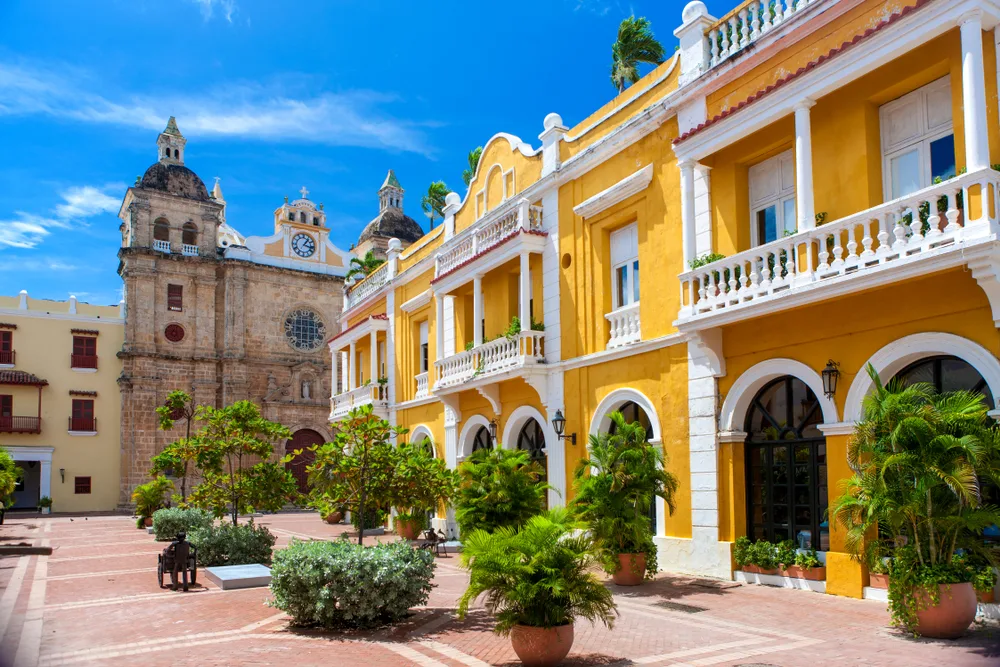
Luis Inacio P Prado/Shutterstock
The best time to visit Cartagena is during the Caribbean dry season, from December to April, when slightly cooler temperatures and less rain make it more pleasant to walk around.
This period hosts some of the most popular events for visitors. Cartagena is located on Colombia’s Caribbean coast, giving it a tropical climate. That means that temperatures are consistently warm all year round, even in months that we may consider “winter” a bit further north.
Temperatures are usually in the 80s on the Fahrenheit scale, no matter the month. The main difference between the seasons is the amount of precipitation.
The dry season lasts from the beginning of December to the end of April. January, February, and March are the driest months of the year, with less than 5% chance of rain per day. The lack of rain brings other benefits — very little cloud coverage and relatively low humidity, for example.
This is the best weather you’ll get all year for exploring. The relatively low humidity makes it more pleasant to walk around the streets of Cartagena.
It’s also ideal beach weather, and the perfect weather for excursions to the rest of Colombia’s Caribbean coast, such as the Rosario Islands. Conditions are great for swimming, kayaking, and other water-based activities. January is also excellent for surfing as it tends to be windy.
In the city itself, this is one of the busier times of year. Expect plenty of travelers to be out and about, soaking up the sunshine, relaxing on the beaches, and touring the historic city center.
If you want to meet other backpackers or travelers on your trip, this is the best time to visit and mingle. The dry season is also the peak season for festivals and events in Cartagena, from religious festivities to international events.
Some of the best events in Cartagena during this period include:
- New Year’s Eve (December 31)
- Hay Festival (January)
- Feast of Our Lady of Candelaria (January/February)
- Barranquilla Carnival (February/March)
- Holy Week and Easter (March/April)
Besides these organized events, expect more informal festivities including film screenings, street parties, and more. Overall, you won’t find a better time to visit than between December and April!
Cheapest Time to Visit Cartagena
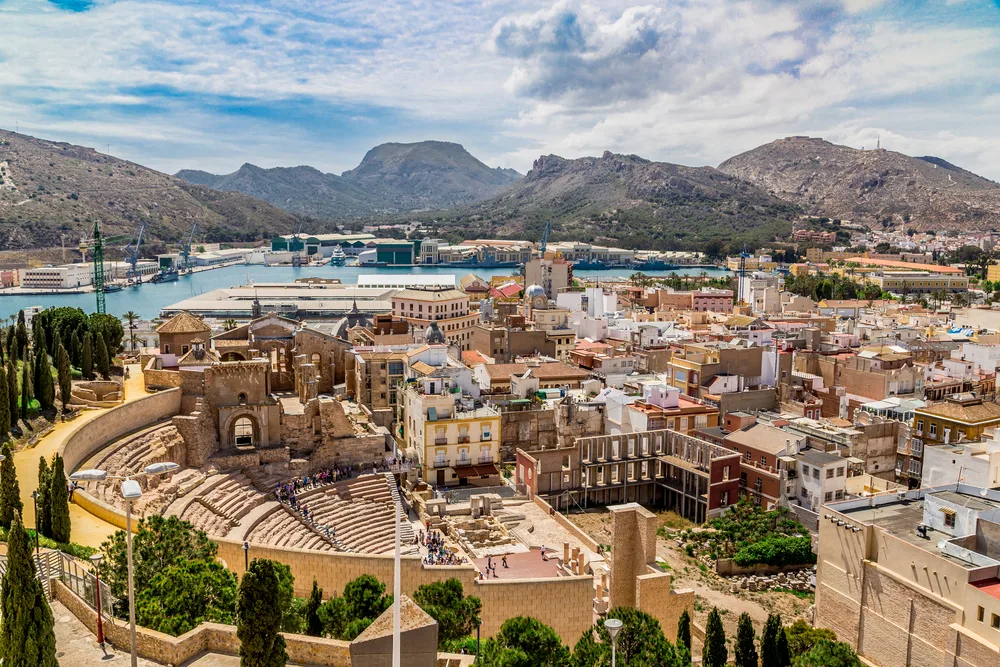
Hakat/Shutterstock
The cheapest time to visit Cartagena is during the peak of the rainy season, from August to November, when rain lowers traveler demand and prices take a nosedive.
This is the height of the rainy season, which tends to chase the tourists seeking beach weather away. Colombian students are only on break in June and July, so demand from families for travel and accommodations drops once August arrives.
The rain and kids returning to school both result in lower hotel prices. In September, the cheapest time to visit Cartagena overall, you can find hotel rooms at rates discounted by 20-40%!
Just keep in mind that Cartagena is the most expensive city in Colombia, so even during the low season, prices won’t be as affordable as you’ll find in other parts of the country.
This is also the best time to find discounts on flights to Cartagena. September and October offer the least expensive flights because fewer people want to visit Cartagena during this time.
If you’re visiting another Colombian city first, this is also the most affordable time to visit the rest of the country and fly into other airports, such as Bogota. August through November are excellent months to enjoy a trip on a smaller budget if you can handle the rain.
Least Busy Time to Visit Cartagena
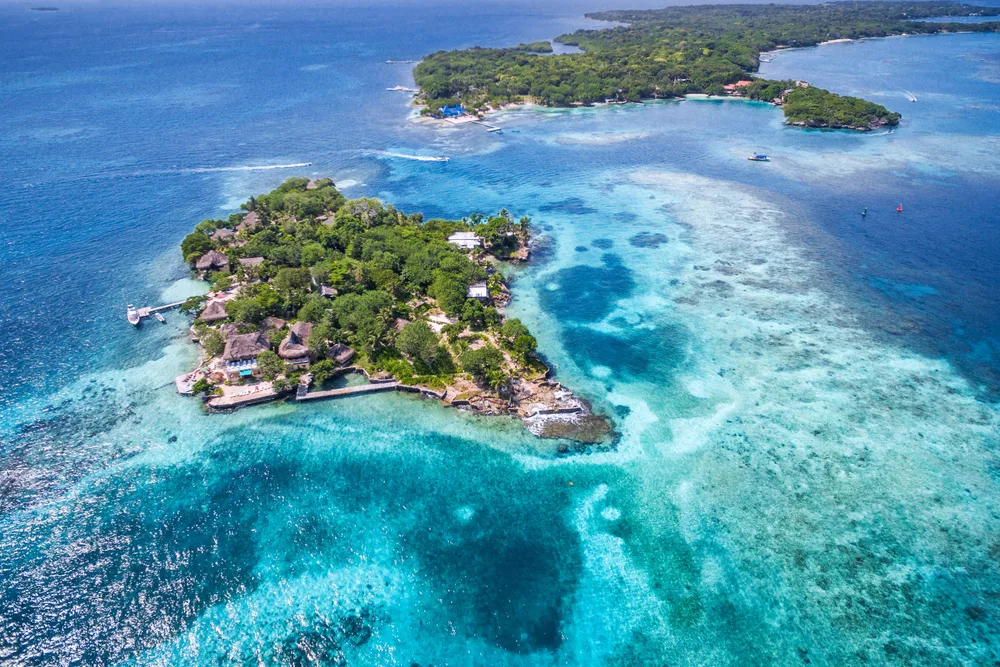
R.M. Nunes/Shutterstock
The least busy times to visit Cartagena are May and the peak of the rainy season, from August to November. May functions as a mini shoulder season in Cartagena.
The dry season ends in April, so people seeking pristine beach weather stop visiting in May. The summer rush, when families start traveling, hasn’t started yet in May, so you can enjoy peace and quiet in the city.
Towards the end of August and into November, the rainy season along the Caribbean coast is at its peak, and kids are back in school. That means there are fewer crowds around and the city feels more authentic.
You’ll see a slight increase in visitors in October, which is when many students have breaks from school. This only lasts for a week or two, so be watchful as you’re planning dates.
The lack of crowds makes October one of the best times to visit the Rosario Islands. This popular vacation destination can feel like a bit of a circus during peak season — think crowds blasting music from their speakers on the beach.
Visiting during the off-season means you’ll get to experience nature without the distraction of crowds. The islands don’t get much stormy weather, just gentle rain, so the seas are relatively calm for sailing and snorkeling trips.
The lack of crowds in the city itself also makes it a lot more pleasant to walk around and get to know the atmosphere. Locals are more relaxed without the pressure of the tourist industry.
You will have to duck indoors every so often to get away from the rain, and there may be a few days when you have to adjust your plans due to the weather.
But these concessions are easily done when you don’t have to wait in line for restaurant reservations—and when you know that you’ve saved a lot of money on your hotel.
Worst Time to Visit Cartagena
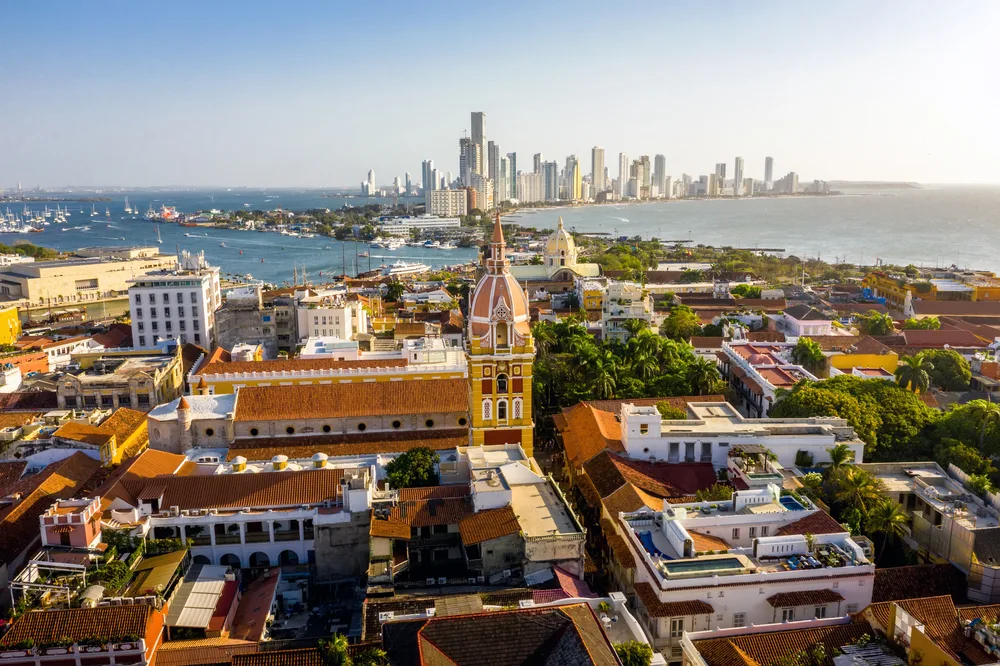
RONEDYA/Shutterstock
The worst time to visit Cartagena is during the height of the rainy season, from September to November, when the city becomes soaked in downpours.
The worst months weather-wise in Cartagena are August, September, and October. October is the rainiest month of the year with nearly 16 days of rain on average.
The chances of the weather ruining your vacation are pretty high during this time. Cartagena is usually not affected by the Caribbean hurricane season, which has its epicenter further north in the region.
However, there have been dangerous incidents in the past, such as the landfall of Hurricane Iota in 2020, which caused bad flooding in Cartagena and at least one fatality on a nearby island.
As long as you’re willing to take a risk with the weather, there are some benefits to traveling during the off-season. The discounts on hotel rooms and other costs are significant, as is the reduction in crowds at popular locations.
The rainy season has far fewer festivals than the dry season, so you won’t get to experience the atmosphere of this famous, party-loving city as much.
However, the few festivals that occur are blowout celebrations. The best is Independence Day on November 11th, which has parades, street dance parties, and crowds spraying each other with foam.
Cartagena by Month: Climate & Activities
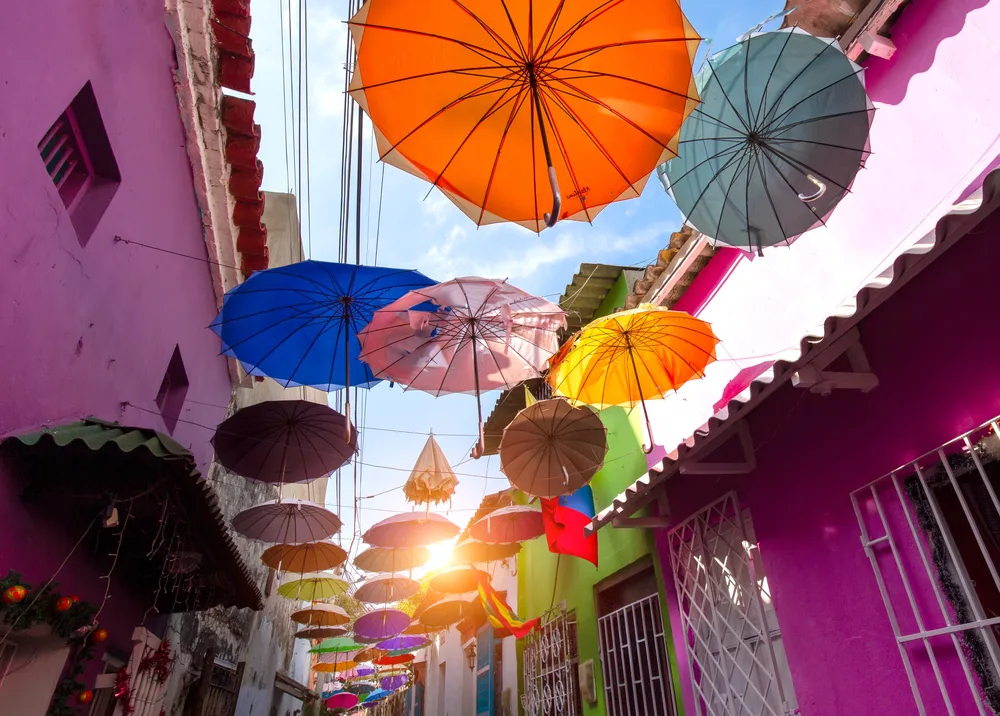
eskystudio/Shutterstock
Still unsure about the best time to visit Cartagena? Take a look at our summary of the weather and climate by month below.
January
In January, summer temperatures in Cartagena range from 23 to 31°C (73-88°F). January is ideal for exploring the historic walled city, enjoying the beaches of Bocagrande, and participating in the lively celebrations of the Cartagena International Music Festival.
February
Similar to January, February maintains warm temperatures between 23 to 31°C (73-88°F). Visitors can enjoy boat trips to the Rosario Islands, explore the Castillo San Felipe de Barajas fortress, and experience the vibrant atmosphere during the Cartagena Carnival.
March
As spring begins, temperatures range from 24 to 31°C (75-88°F). March is perfect for strolling through the Getsemaní neighborhood’s street art, taking a horse-drawn carriage tour, and attending the Hay Festival of Literature and Arts.
April
Spring temperatures in Cartagena range from 25 to 32°C (77-90°F). It’s an ideal time for exploring the San Pedro Claver Church and Convent, enjoying seafood at local markets, and experiencing the Semana Santa (Holy Week) festivities.
May
May sees temperatures ranging from 26 to 32°C (79-90°F). It’s a great month for walking along the historic city walls, taking boat tours to the Islas del Rosario, and attending cultural events at the Teatro Heredia.
June
Summer arrives with temperatures between 26 to 32°C (79-90°F). June offers opportunities for relaxing on the Playa Blanca beach, exploring the vibrant street markets, and enjoying the local cuisine in the Old City.
July
July maintains warm temperatures from 26 to 32°C (79-90°F). It’s a popular month for exploring the Palace of the Inquisition, taking a sunset cruise in Cartagena Bay, and attending the Cartagena International Film Festival.
August
Temperatures in August range from 26 to 32°C (79-90°F). It’s an excellent time for visiting the San Felipe de Barajas Castle at sunset, exploring the Plaza Santo Domingo, and enjoying the diverse nightlife in Getsemaní.
September
As fall begins, temperatures range from 26 to 32°C (79-90°F). September offers a pleasant transition, with opportunities for exploring the La Popa Monastery, attending the Cartagena Fashion Week, and enjoying the beaches.
October
October sees temperatures ranging from 26 to 31°C (79-88°F). It’s a great month for exploring the Convento de la Popa, taking a city bike tour, and participating in cultural events at the Teatro Adolfo Mejía.
November
Fall temperatures range from 25 to 31°C (77-88°F). November is perfect for walking along the charming streets of Getsemaní, exploring the Castillo San Felipe de Barajas, and attending the Cartagena Independence Day celebrations.
December
Winter returns with temperatures ranging from 24 to 31°C (75-88°F). December brings opportunities for holiday celebrations, enjoying the festive decorations in the Old City, and experiencing the Christmas and New Year’s festivities.
Frequently Asked Questions
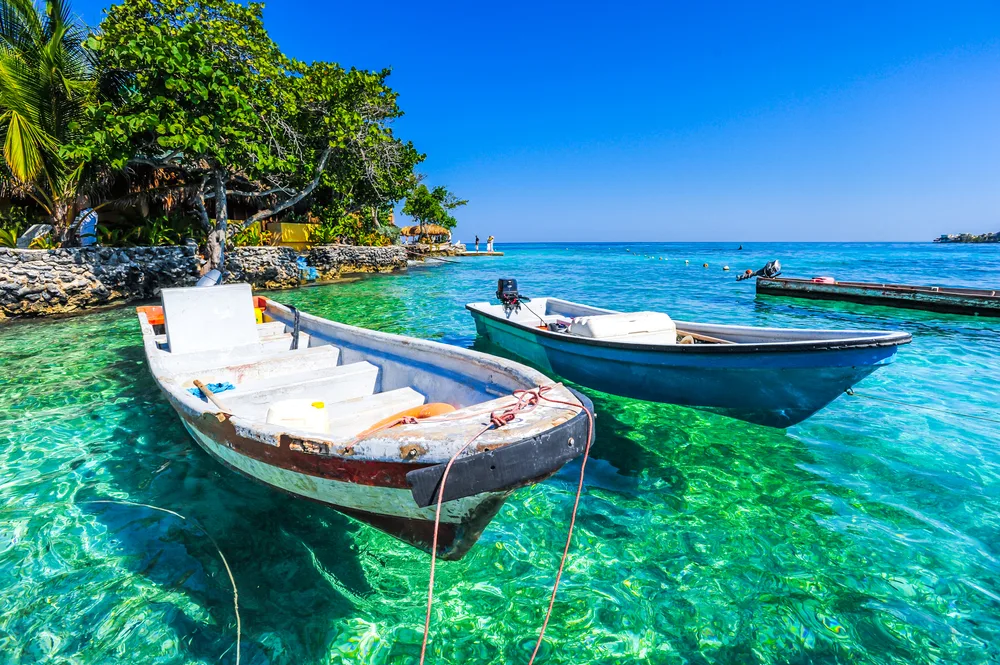
Venturelli Luca/Shutterstock
Here are a few of the most common questions people have asked about visiting Cartagena:
When is the best time of year to visit Cartagena?
The best time of year to visit Cartagena is during the dry season, from December to April, which has the best weather and most festivals.
Does Cartagena have a rainy season?
Cartagena has a tropical climate, which means it has a rainy season. The rainy season lasts from May to November.
What is the hottest month in Cartagena?
The hottest month in Cartagena is July, with average temperatures of 87 degrees Fahrenheit. The high humidity makes it feel even hotter.
How many days do you need in Cartagena?
You need at least three days in Cartagena. You want to have enough time not just for all the historic sites, but also for relaxing on the beach.
Which is better: Medellin or Cartagena?
Cartagena has an advantage over Medellin because it’s located on the beach and has a better historic center. However, Medellin is a bigger urban destination with more to do.
So, What’s the Best Time to Visit Cartagena?
The best time to visit Cartagena is during the city’s dry season, from December to April, when the weather is beautiful. The rainy season brings heavy showers, especially from August to October, but also fewer crowds and bigger discounts.
So, with so much to see and do and countless amazing times to visit, what are you waiting for — book your trip today and experience for yourself all that Cartagena has to offer. Happy travels!



